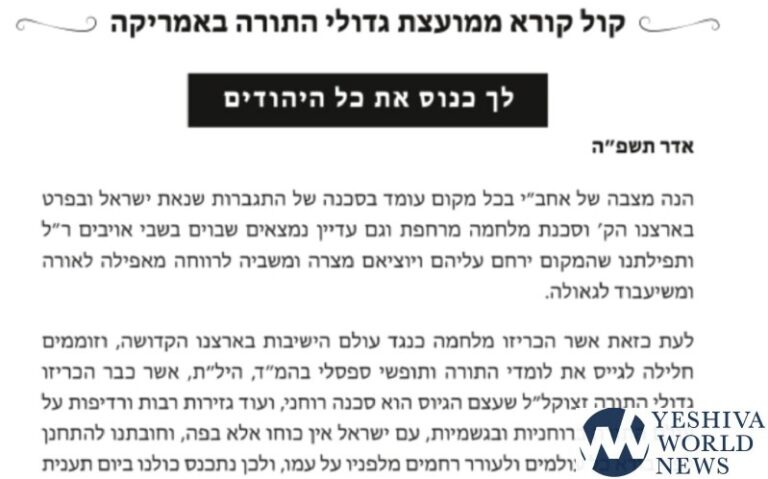(By Rabbi Yair Hoffman for the Five Towns Jewish Times)
What? Rav Elyashiv’s grandfather invented the first Anger Management program? Well, let’s start at the beginning.
In secular circles it is thought that anger management programs first originated in the 1970’s by clinical psychologist Dr. Raymond Novaco, a professor at UC Irvine.
Interestingly enough, Rav Elyashiv zatzal’s grandfather, Rav Moshe Levinson zt”l developed an anger management program well before that. In 1910, Rav Levinson printed his highly developed anger management program in a sefer entitled, “M’aneh Rach.” It was published in Piotrków Trybunalski, in Congress Poland – then a puppet state of the Czarist Russian Empire. It was Rav Levinson’s third sefer.
BACKGROUND TO THE SEFER
The sefer had a haskamah from the Ridbaz, the Av Beis Din of Slutzk. The Ridbaz, however, left to America and then to Eretz Yisroel in 1900 – so Rav Levinson must have been working on it for a while and probably finished it well before 1900.
The M’aneh Rach was carefully analyzed in a remarkable new book entitled “Fundamentals of Jewish Conflict Resolution by Dr. Howard Kaminsky. Rav Levinson states that there is nothing particularly new in his program – rather he gathered together all the Rabbinic statements that pertain to anger and he explains them. He also, however, organizes and arranges them in such a manner that they constitute a genuine program. In addition, Rav Levinson provides advice, strategies, and suggestions.
Rav Levinson writes that if someone reviews his work two or three times, he should be able to conquer anger. He writes that the fact that they are all gathered together and explained will provide the person with much greater clarity as to the matter and will thus be able to overcome the impediments to overcoming an anger problem.
Rav Levinson writes that if one combines both strategies in cognition and as well as behavior – he will succeed in overcoming anger. One must also engage in introspection and develop self-awareness. Rav Levinson provides strategies to gain this self-awareness.
A source that Rav Levinson used in his M’aneh Rach, Dr. Kaminsky points out, is the Reishis Chochma by Rav Eliyahu de Vidas. He lived in the 1500’s some 400 years before Rav Levinson.
So what does Rav Levinson advise to do?
- Avoid people and situations that are sources of stress.
- When you feel that you are getting angry – don’t respond.
- When it is necessary to, in fact, respond – let it percolate overnight. This suggestion is also found in the sefer Chassidim – siman 83 and Siman 655, Dr. Kaminsky points out.
- When it is necessary to respond it should be done in a gentle and soft tone.
- One should give the other person the benefit of the doubt.
- One should try to take the other person’s perspective rather than blast them.
- Time should be spent thinking about how bad it is to lose one’s temper.
- Time should also be spent thinking about how great the merit is to control one’s anger.
- One should be aware at the tip of one’s tongue, both the short term and long term implications of losing one’s temper.
- One should put into perspective the comment that caused him or her to get upset in the first place.
- One should be aware of the notion of mida k’neged mida – that what goes around comes around. If you are quick to forgive and overlook – then that is how Hashem will deal with you in the future. If, however, you jump on every possible interpretation of a slip up of another person – then that is how Hashem will react to your foibles, slip ups and issues.
- One should also be aware that everything that Hashem does is for a reason – including what had just happened that caused you to become angry. You, however, have the capability of controlling your response.
Rav levinson places an extraordinary emphasis on the notion of metinus – deliberation. It is a theme that he stresses time and again. In his view the idea of slowing down of our reactions to provocations.
In the period of Sefira, especially after the period of BaHaB sets in – it is very worthwhile for us to strive to develop our character traits. The very best middah to start with is kaas – anger. This is because it can affect so many other people. Our anger can destroy marriages, our children’s lives, our work atmosphere, and so many other areas of life.
One must realize that Chazal compare anger to Avodah Zarah – idol – worship for a reason. For those who will find the Hebrew in M’aneh Rach too difficult, a fascinating overview of this work as well as other similar ones can be found in Dr. Kaminsky’s Fundamentals of Jewish Conflict Resolution – chapter nine – entitled Jewish Anger Management.
This article was written l’ilui nishmas the author’s father on his tenth yartzeit this hay iyar.
The author can be reached at [email protected]












One Response
Anger is also a good midah, we see haShem gets angry and so does Moshe, so if anger is a totally bad thing, how could haShem and Moshe get angry?
the answer is that normally it is a bad mida, but sometimes it can be used for good and it depends on the situation.